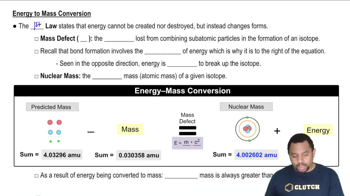The reaction A¡products was monitored as a function of time. The results are shown here. Time (s) [A] (M) 0 1.000 25 0.914 50 0.829 75 0.744 100 0.659 125 0.573 150 0.488 175 0.403 200 0.318 Determine the order of the reaction and the value of the rate constant. What is the rate of reaction when [A] = 0.10 M?
Ch.15 - Chemical Kinetics
Chapter 15, Problem 61
Silver nitrate solutions are often used to plate silver onto other metals. What is the maximum amount of silver (in grams) that can be plated out of 4.8 L of an AgNO3 solution containing 3.4% Ag by mass? Assume that the density of the solution is 1.01 g/mL.
 Verified step by step guidance
Verified step by step guidance1
Step 1: First, we need to calculate the total mass of the solution. We can do this by multiplying the volume of the solution by its density. In this case, we have a volume of 4.8 L (which is equivalent to 4800 mL) and a density of 1.01 g/mL. So, the total mass of the solution is 4800 mL * 1.01 g/mL.
Step 2: Next, we need to find the mass of Ag in the solution. We know that the solution contains 3.4% Ag by mass. This means that for every 100 g of solution, there are 3.4 g of Ag. So, we can calculate the mass of Ag in the solution by multiplying the total mass of the solution by 3.4% (or 0.034).
Step 3: The result from step 2 will give us the mass of Ag in grams. This is the maximum amount of silver that can be plated out of the solution.
Step 4: Remember to check your units and make sure they are consistent throughout the problem. In this case, we started with volume in liters, converted it to milliliters, and then used the density to find the mass in grams.
Step 5: Finally, always review your work to ensure that it makes sense. The mass of Ag should be a reasonable value given the volume and concentration of the solution.

Verified video answer for a similar problem:
This video solution was recommended by our tutors as helpful for the problem above.
Video duration:
3mWas this helpful?
Key Concepts
Here are the essential concepts you must grasp in order to answer the question correctly.
Concentration and Mass Percent
Mass percent is a way of expressing the concentration of a solute in a solution, calculated as the mass of the solute divided by the total mass of the solution, multiplied by 100. In this case, a 3.4% Ag by mass means that in every 100 grams of the solution, there are 3.4 grams of silver. Understanding this concept is crucial for determining the amount of silver present in the given volume of solution.
Recommended video:
Guided course

Mass Percent Calculation
Volume to Mass Conversion
To find the mass of a solution from its volume, the density of the solution is used. Density is defined as mass per unit volume, and in this scenario, the density of the AgNO3 solution is given as 1.01 g/mL. By multiplying the volume of the solution (in mL) by its density, one can calculate the total mass of the solution, which is necessary for further calculations regarding the amount of silver.
Recommended video:
Guided course

Energy to Mass Conversion
Stoichiometry in Chemical Reactions
Stoichiometry involves the calculation of reactants and products in chemical reactions based on the conservation of mass. In this context, it helps determine how much silver can be plated from the silver nitrate solution. By knowing the mass of silver in the solution, one can apply stoichiometric principles to find the maximum amount of silver that can be deposited onto another metal.
Recommended video:
Guided course

Stoichiometry Concept
Related Practice
Textbook Question
Textbook Question
This reaction was monitored as a function of time: A → B + C A plot of ln[A] versus time yields a straight line with slope -0.0105/s. a. What is the value of the rate constant (k) for this reaction at this temperature?
Textbook Question
This reaction was monitored as a function of time: AB → A + B A plot of 1/[AB] versus time yields a straight line with a slope of +0.25/Ms. b. Write the rate law for the reaction.
Textbook Question
The decomposition of XY is second order in XY and has a rate constant of 7.02⨉10-3 M-1• s-1 at a certain temperature. a. What is the half-life for this reaction at an initial concentration of 0.100 M?
